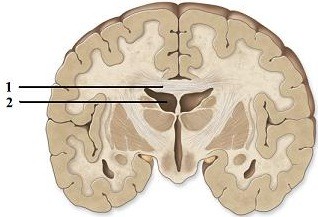 This figure shows a frontal section of the cerebrum. What structure does number 2 indicate?
This figure shows a frontal section of the cerebrum. What structure does number 2 indicate?
A. Third ventricle
B. Cerebral nuclei
C. Fourth ventricle
D. Corpus callosum
E. Lateral ventricle
Answer: E
You might also like to view...
You are trying to design a new drug to painlessly euthanize animals. Your plan is to design a molecule that blocks the action of one of the following pumps so that heart muscle stays contracted and blood movement is stopped. Which would be effective?
A. Na+/Ca2+-exchangers on the cell membrane B. Ca 2+-ATPase pumps on the cell membrane C. Ca2+-ATPase pumps on the sarcoplasmic reticulum D. Na+/K+-ATPase pumps on the cell membrane E. None of these would result in sustained muscle contraction
A smoker sees his doctor because he has a persistent cough and is short of breath after very little exertion. What diagnosis will the doctor make and what can the person expect if he does not quit smoking?
What will be an ideal response?
Cardiac muscle has more mitochondria and depends less on a continual supply of oxygen than does skeletal muscle
Indicate whether the statement is true or false
Answer the following statements true (T) or false (F)
1. In the ATP-ADP cycle, the most important thing being added or lost in the ATP is energy. 2. The catabolic reaction for glucose is called glycogenesis. 3. The end product of glycogenesis is glycogen. 4. A person who has diabetes mellitus has a surplus of glucose and insulin in the blood. 5. Both insulin and hydrocortisone lower the blood concentration of glucose.